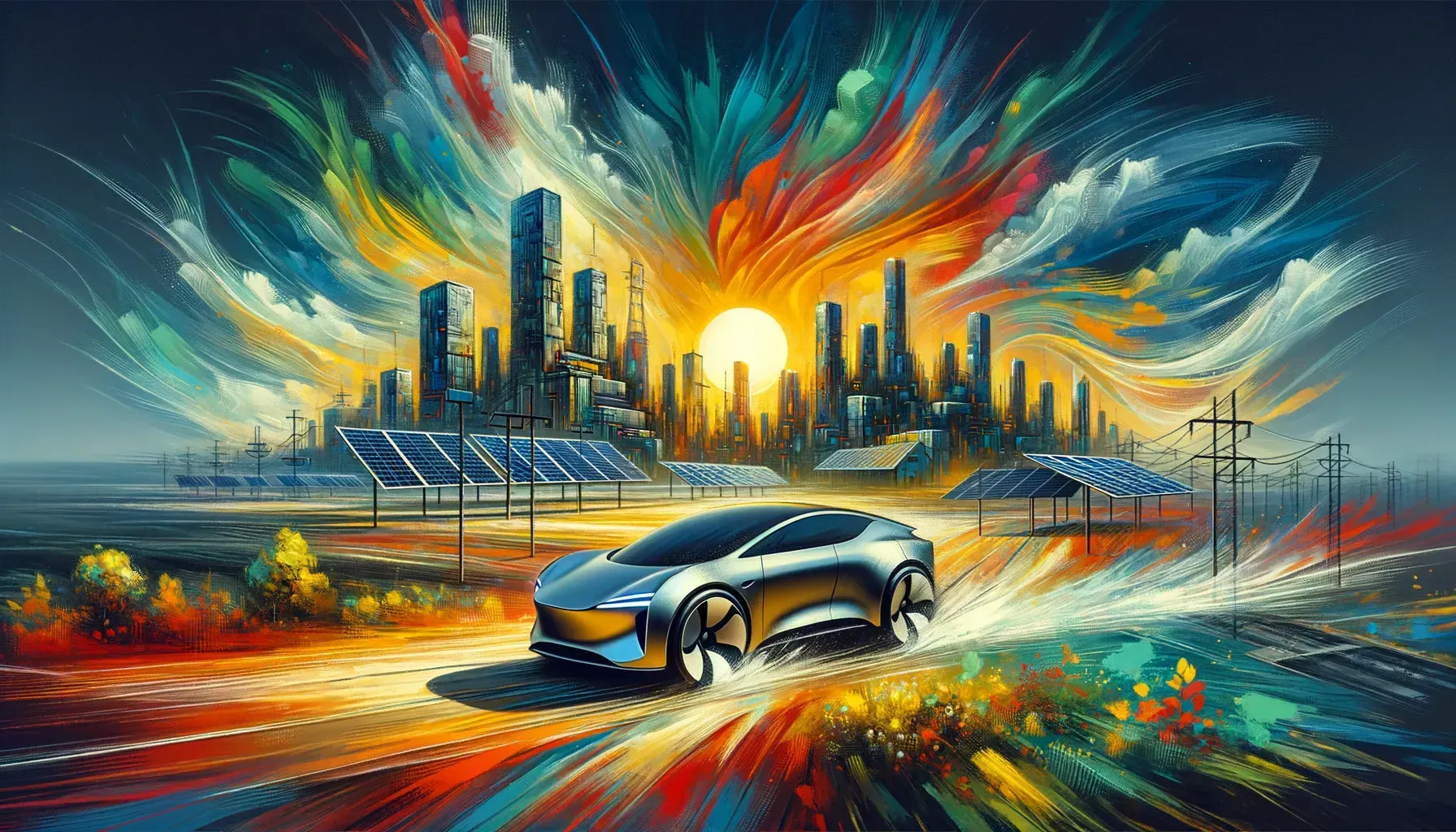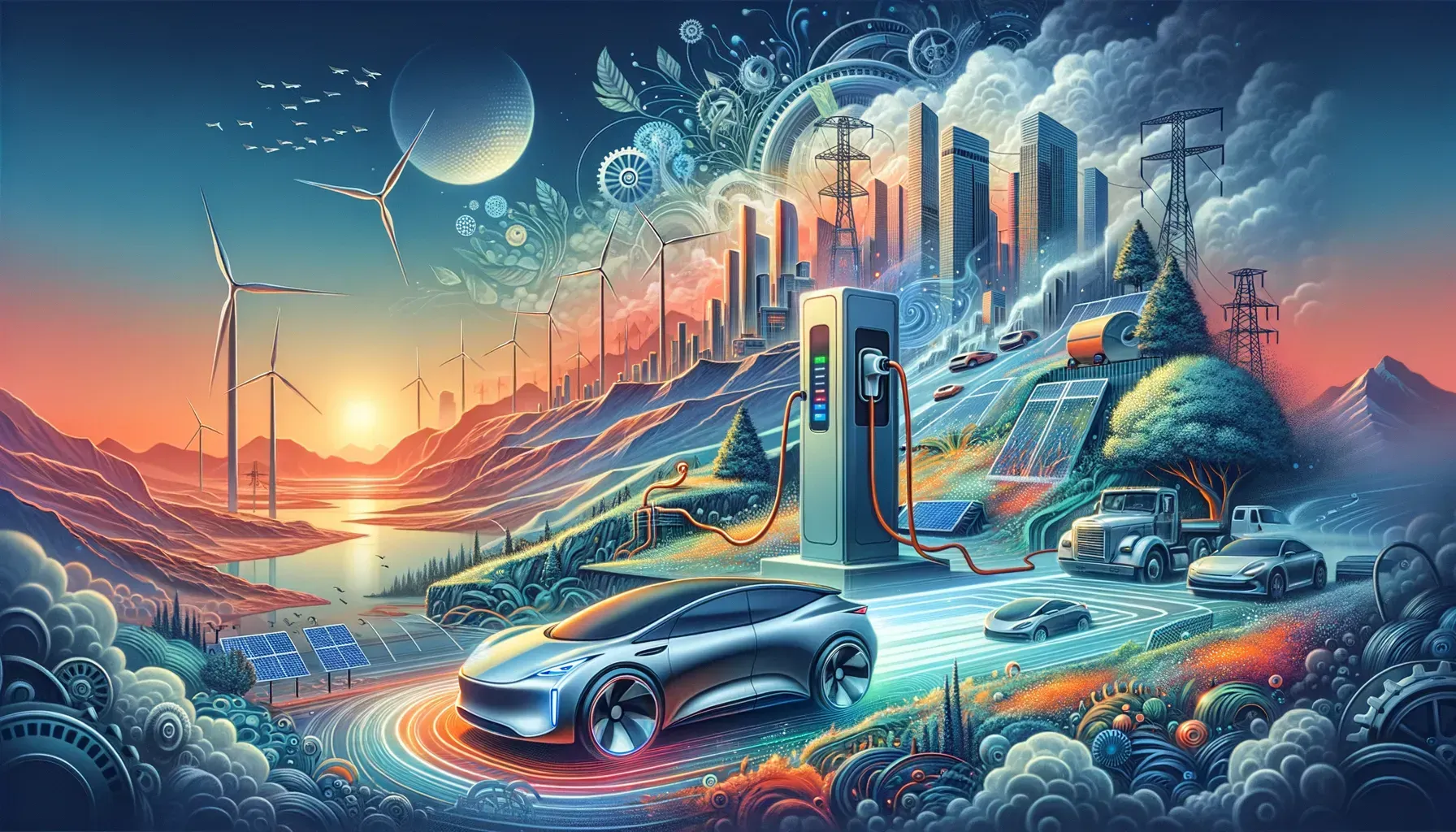The Transformative Role of AI in EV Charging: Insights and Implications

Imagine a world where charging your electric vehicle (EV) is as seamless as charging your smartphone. Thanks to advances in artificial intelligence (AI), this dream is becoming a reality. Recent studies are uncovering insights that promise not just convenience for drivers but also critical solutions for our aging power grids. In this post, we’ll take a deep dive into the fascinating intersection of AI and electric vehicle charging, shedding light on innovations that could pave the way for more reliable energy consumption.
AI and the Future of EV Charging: A Game Changer for Utilities
As electric vehicles (EVs) become more common, their charging can impact our power grid in surprising ways. The good news? Artificial intelligence (AI) is stepping in to help utilities manage this complex dance. In a recent pilot study conducted by the University of Michigan Transportation Research Institute (UMTRI) and Utilidata, researchers discovered critical insights into how AI can improve EV charging practices. This exploration reveals several pathways that could reshape our approach to electricity delivery for EVs.
1. Understanding Real-Time Data for Grid Management
Imagine you're at a busy restaurant, and a dozen people are trying to place their orders at once. The chaos could lead to errors in orders and long wait times. Similarly, our electrical grid can become overwhelmed when numerous EVs plug in simultaneously. This is where real-time data comes into play. By leveraging AI, utilities can monitor and manage power usage as it happens.
- With real-time data, they can track energy demand spikes.
- Utilities can spot inefficiencies almost instantly.
- They can adjust power flow to ensure stability.
As Siobhan Powell from ETH Zürich aptly noted, "There's a big role for AI to play at the grid edge." This means AI technology can help understand and stabilize our power systems, preventing potential grid failures.
2. Forecasting Demand Spikes with Machine Learning
Forecasting demand spikes may sound technical, but it's about predicting when the power needs surge. Power needs fluctuate throughout the day. For example, when everyone returns home from work, many EVs might plug in for charging. Using machine learning algorithms, utilities can analyze patterns in EV charging behavior.
These patterns help predict future energy demands. By anticipating when and where the spikes might occur , utilities can better manage resources and avoid blackouts. AI can act like a weather forecast for electricity, ensuring everything flows smoothly.
3. Identifying Inefficiencies in Current Charging Practices
Not all charging practices are effective. The pilot study highlighted common inefficiencies. Some EVs draw power inconsistently, leading to wasted energy. Think of it as having a faucet that keeps dripping water even when it’s turned off. These inefficiencies can also lead to wear and tear on charging equipment, which could eventually lead to breakdowns.
By utilizing AI, utilities can track these behaviors and identify problematic patterns. This ensures drivers have a reliable experience, minimizing the frustration associated with malfunctioning chargers. Better maintenance and operational insights can directly enhance the EV charging experience.
Case Study Insights
The collaboration between UMTRI and Utilidata involved a detailed pilot study from March to June of the previous year. Researchers installed electric meter adapters at six EV charging stations to gather analytics. The experiment also entailed measuring how drivers charged their vehicles on campus during that time frame. This analysis provided a wealth of information about EV charging dynamics.
| Study Detail | Information |
|---|---|
| Conducted By | University of Michigan Transportation Research Institute (UMTRI) & Utilidata |
| Analysis Period | March - June (Previous Year) |
| Focus Areas | Charging behavior, grid impact, real-time data analysis |
What's compelling is that this research can pave the way for a more efficient and reliable charging infrastructure. As utilities invest in AI and data-driven decision-making, the future of EV charging looks brighter than ever.
Conclusion
In summary, the integration of AI into EV charging practices stands to revolutionize how we manage our electric grids. With smarter forecasting, real-time data management, and the identification of inefficiencies, utilities can ensure a smoother transition to EVs. It's a vital step towards not just accommodating electric vehicles, but truly embracing an electrified future.
Electric Vehicle Charging Behavior: Patterns and Anomalies
As electric vehicles (EVs) become increasingly popular, understanding their charging behavior is essential. Plugging in an EV might seem simple, but it can involve complexities that not everyone is aware of. Many drivers don’t realize how their charging habits affect the overall grid and their vehicles. One significant concern that has surfaced is the issue of short-cycling .
The Issue of Short-Cycling in EVs
Short-cycling occurs when an EV stops and starts charging rapidly, often after the vehicle’s battery is fully charged. It might seem harmless, but this repetitive process is far from optimal. How many times do we really think about what happens behind the scenes when we plug in our vehicles? Short-cycling not only wastes energy , but also creates unnecessary wear and tear on charging equipment.
- Inconsistent power draw
- Increased energy costs
- Potential overheating of electrical components
Yingchen Zhang, a vice president at Utilidata, expressed the need for greater transparency in this area. He noted,
“There's a great need to really open up all this data.”
Impact of Inconsistent Charging on Power Quality
Another issue arising from erratic charging behaviors is the impact on power quality . When charging stations face fluctuating electricity demands, it can lead to lower power quality . This occurs when electricity deviates from its ideal voltage and frequency ranges. If you've ever noticed flickering lights in your home, you have felt the effects of low power quality.
Inconsistent charging can cause:
- Overheating wires
- Damage to transformers
- Compromised equipment lifespan
By understanding the effects of short-cycling, researchers aim to help utilities better manage their power grid. This can save costs and ensure a more reliable charging experience for EV drivers.
Energy Inefficiencies and Their Consequences for Drivers
The real kicker is that short-cycling leads to energy inefficiencies. It's much like leaving the lights on in a room where no one is present. Although you might not notice it immediately, those small inefficiencies add up. They can translate into higher electricity bills and reduced driving ranges for EV drivers.
Moreover, erratic charging habits can lead to equipment failures – something that every EV driver would prefer to avoid. The consequences of short-cycling don't just stop with power quality and energy waste. There are real costs associated with maintaining and repairing faulty charging stations.
| Issue | Impact |
|---|---|
| Short-Cycling | Overheating of electrical components |
Researchers have discovered that the patterns of EV charging behaviors can significantly impact how utilities manage energy during peak hours. If more drivers become aware of their charging habits, they could potentially improve both their experiences and the reliability of the grid.
Ultimately, by shedding light on short-cycling and its implications, everyone can make informed decisions regarding their charging habits. Increased awareness can lead to changes in behavior and reduce instances of energy waste. As Yingchen Zhang mentioned, understanding EV behaviors is key to promoting efficiency and longevity within the electrical system. So why not take that step? After all, the efficiency of one driver can make a difference for the entire community.
Addressing Concerns: Can AI Mitigate Potential Issues?
The rise of electric vehicles (EVs) brings with it a set of concerns regarding the impact on power grids. Many people fear that charging a high number of EVs could lead to outages. However, these fears are often based on misconceptions. As we delve deeper, we can see how AI can play a pivotal role in addressing these concerns.
Overcoming Misconceptions About EV Charging Impact on Grids
EV charging can indeed put a strain on the power grid, but not to the extent many imagine. Understanding the true behavior of EVs is essential. For example, widespread charging at peak times can lead to increased demand. Yet, it’s crucial to recognize that utilities have protocols in place to manage this. AI can analyze charging patterns and help utilities predict peak demand times. By doing so, utility companies can be better prepared to manage fluctuations in electricity demand.
So, what do most people fear? The primary concern is about consistent power supply and the possibility of outages. However, it's essential to shift our focus from these fears to the reality of EV adoption. Zhang notes,
“So actually revealing this information will diminish a lot of those fears.”When more people understand the actual behavior of EV charging, especially in terms of timing and variability, their concerns may lessen significantly.
- Utilities can provide information about optimal charging times.
- Public awareness campaigns can clarify misconceptions.
- Real-time data can be shared with EV users for better charging habits.
Possible Preventative Measures Utilities Can Take
Utility companies can adopt various proactive strategies to alleviate concerns regarding EV charging. The use of AI is one of the most promising approaches. By analyzing data from charging stations and vehicles, they can anticipate potential issues before they escalate.
For instance, a recent study included AI applications to monitor charging habits. With this data, utilities can:
- Identify patterns in EV usage through real-time analytics.
- Adjust power distribution dynamically based on demand.
- Enhance infrastructure to ensure charging stations meet demand without overloading the grid.
This proactive stance not only aids in managing the grid but also provides drivers with information. Knowing when and where to charge can help manage costs and reduce peak load.
The Low Probability of Outages Despite Concerns
It's crucial to emphasize that while the concerns about electric vehicle charging and grid strain are valid, the actual probability of widespread outages remains low. Zhang highlights,
“I wouldn’t jump to outages,”considering all the steps utilities can take to mitigate risks.
Short-cycling and other charging behaviors may disrupt power quality in localized areas. However, the infrastructure is designed to handle fluctuations. Public fears may increase when EV adoption rates surge, but the implementation of AI technology offers a guide to understanding and managing these changes.
The evolution of AI can indeed transform our energy landscape. By employing AI tools like predictive analytics, utilities can adapt to the unpredictable nature of charging. This kind of insight is invaluable in preparing for the future of an electrified vehicle fleet.
Reassessing Public Perception
Understanding the behaviors of electric vehicles and the technologies behind them can bridge the gap between public concern and actual risk. Proactive engagement is key. Utilities must foster transparency in their operations and findings regarding EV behavior. By doing so, they can empower customers with knowledge.
As the study indicates, shedding light on the real challenges and capabilities surrounding EVs can significantly reduce skepticism. The more the public learns about EV technology and its impact, the less fear they are likely to harbor.
As a society, it's imperative to embrace this transition to electric vehicles. With AI, both utility companies and consumers can work together towards an informed future. After all, addressing misconceptions today can bolster our energy resilience for tomorrow.
Preparing the Grid for a Sustainable Future
The electricity grid is at a pivotal juncture. With the rapid rise of electric vehicles (EVs) and renewable energy sources, there’s an urgent need to adapt the current infrastructure. It’s not just about keeping the lights on anymore. The grid must evolve to form a sustainable future. How can we ensure it meets the changing demands? Let’s break it down.
1. Adapting Infrastructure to Accommodate New Technologies
As EVs gain popularity, they play a significant role in driving grid evolution. Traditional electricity grids were designed for predictable, one-way power flow. That’s quickly becoming outdated. Now, varying sources of power such as solar and wind need to be integrated.
- Smart Grids: These grids can manage the flow of electricity more effectively. With the help of real-time data from AI, utilities can predict when and where demand will spike.
- Upgrading Equipment: Old transformers and substations may not handle the increased load from EV charging stations. New technologies need to be installed to keep everything running smoothly.
These changes may seem daunting, but they are essential for handling the increased electricity demand. Just as we need to charge our devices regularly, the grid requires routine upgrades to keep functioning. So why not embrace it? Why cling to outdated methods?
2. The Potential of EV Batteries as Virtual Power Plants
Imagine a scenario where your parked EV is not just a vehicle but also a power source. When charged, these vehicles can feed energy back into the grid during peak hours. This is the concept of using EV batteries as virtual power plants.
- Energy Storage: EVs can store renewable energy, allowing for more efficient energy distribution.
- Cost Management: By utilizing EVs as power sources, utilities can reduce strain during high demand times. This could lead to lower electricity costs for everyone.
This is more than just creative thinking; it’s becoming a reality. Automakers are exploring how this can work, making EVs even more attractive to consumers. But is it enough? We’ll need to stay ahead of the curve.
3. Role of Renewable Energy Sources in EV Transition
Renewable energy, such as solar and wind, isn’t just a supplement; it’s becoming a core part of our electricity generation. As EV adoption rises, their integration with renewable sources becomes critical.
- Decentralized Energy Production: The shift from centralized power plants to more distributed energy generation benefits grid reliability.
- Reduced Emissions: Combining EVs and renewables helps decrease greenhouse gases and air pollution.
Statistics show that as more renewable energy sources are integrated with EV technologies, the benefits multiply. In many cities, cleaner energy means not just less pollution but more reliable service too.
4. Future Scenarios for Integrating EVs and Renewables
What does the future hold? The integration of EVs and renewable energy will bring both challenges and opportunities. Automating grid management through machine learning becomes essential. The underlying issues with charging behaviors, such as unstable power draws, need understanding. These problems can lead to energy waste and equipment failure — exactly what we want to avoid.
"We need this transition to happen... but we can do them," Powell concludes.
With proper preparation, the future can be bright. Innovations in AI can lend a hand in making the grid smarter and more efficient. As utilities learn to manage variables like fluctuating power demand and vehicle charging patterns, they will offer smoother service. The reliability of the grid could very well improve through these innovations. Isn't that a relief?
Statistics on Renewable Energy Integration
While we don’t have specific numbers to present right now, studies confirm that the potential to better integrate renewable energy into EV technology rapidly increases. This improvement has the power to enhance grid reliability, making it a crucial part of the conversation.
In conclusion, adapting our infrastructure to accommodate new technologies, harnessing EV batteries, and integrating renewable energy are key for the grid's sustainable future. Every step taken today can pave the way for a cleaner, more reliable energy tomorrow.
Conclusion: Embracing Change and Innovation in EV Charging
The world of electric vehicles (EVs) is evolving rapidly. Significant advancements are taking place in charging infrastructure, largely driven by the advent of artificial intelligence (AI). These changes have the potential to revolutionize how drivers experience the process of charging their vehicles. As AI continues to shape the landscape of EV charging, it’s crucial to summarize its impact, potential improvements, and the importance of community involvement.
Summarizing the Impact of AI on EV Charging Infrastructure
AI technologies are proving to be invaluable in understanding and improving EV charging behavior. A recent study conducted by the University of Michigan Transportation Research Institute (UMTRI) has illuminated how AI can help utility companies manage electricity demand. By installing AI-powered electric meter adapters at charging stations, researchers gained insights into power quality and usage patterns. What did they find? Charging systems often draw power inconsistently. Inconsistent power quality can wear out equipment and waste energy. This is especially troublesome as more drivers transition to electric vehicles.
From predicting when and where EVs will charge, to alerting utilities about potential power grid impacts, AI plays a big role at the grid edge. Does this foresight enhance the reliability of EV charging? Certainly! And a reliable charging experience significantly boosts consumer confidence in making the switch to electric vehicles.
The Potential for Improved User Experience in Charging
Imagine this: a driver plugging in their car at a charging station and receiving instant, data-driven recommendations on when to charge. AI can optimize the user experience by advising on peak times and locations for charging, thus reducing wait times and ensuring drivers always find an available spot. These advancements can turn the somewhat cumbersome process of charging into a seamless experience.
Furthermore, AI can help prevent issues like short-cycling, where chargers stop and start inappropriately, wasting energy and stressing equipment. As Utilidata’s VP of Product Solutions, Yingchen Zhang, mentioned, “There’s a great need to really open up all this data.” This data transparency will lead to smarter decision-making, better infrastructure planning, and ultimately, happier EV drivers.
Encouraging Community Involvement and Understanding of EV Technology
For a successful transition to electric vehicles, community involvement cannot be overlooked. It’s essential for local communities to understand the technology behind EV charging. Educational initiatives can empower individuals and encourage informed discussions within neighborhoods. As fears around EV adoption often stem from a lack of knowledge, it’s crucial to unveil the realities of EV behavior.
By organizing workshops and demonstrations, communities can demystify EV technology. Local governments and organizations play a fundamental role in promoting this understanding. When residents feel included in the conversation, their apprehensions may diminish, paving the way for a more extensive adoption of electric vehicles.
Reflection on the Future
It is evident that the future of EV charging hinges on our willingness to embrace AI and innovative solutions. This transition will not only enhance user experience but also prepare the energy sector for the demands of an electrified future. Continued innovation in the energy sector isn't just desirable; it's necessary for a sustainable future.
In conclusion, the merging of AI and EVs is an exciting frontier that promises to enhance our driving experience while ensuring a reliable grid. However, this transformation hinges on community involvement and understanding. Can we embrace these changes together? The answer lies in our readiness to engage with new technologies and explore their vast potential.
TL;DR: Embracing AI in EV charging infrastructure enhances reliability and user experience while promoting community understanding, paving the way for a sustainable energy future.











